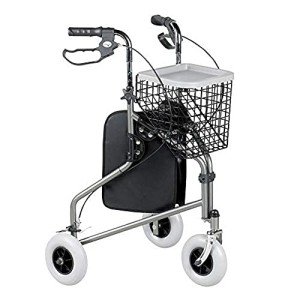What’s The Most Common Rollator Walker Debate Doesn’t Have To Be As Black And White As You May Think
The Comprehensive Guide to Rollator Walkers
As the population ages, the need for mobility aids like rollator walkers has actually risen. These walkers provide stability, assistance, and liberty of movement for people dealing with mobility issues, be they temporary or persistent. Understanding the kinds of rollator walkers readily available, their benefits, features, and how to choose the best one can significantly boost the lifestyle for both the user and their caretakers.

What is a Rollator Walker?
A rollator walker is a mobility aid designed to assist individuals keep their self-reliance while walking. It features a frame with four wheels, hand brakes, and a seat, making it appropriate for users needing extra assistance without the full restrictions of traditional walkers.

Secret Features of Rollator Walkers
Rollator walkers come equipped with various features developed to boost user experience. Here are some of the most typical functions:
- Four-Wheel Design: The most appreciable function is its 4 wheels, which enable smoother transitions over different surfaces.
- Cushioned Seat: Many rollators included an integrated seat, providing a resting point for users who might tire quickly.
- Hand Brakes: Most designs have hand brakes that allow users to protect the walker in place when sitting or browsing irregular surfaces.
- Storage Options: Many rollators consist of a basket or storage pouch for personal products, such as water bottles or small bags.
- Adjustable Height: Users can personalize the height of the deals with for optimal comfort and posture.
Benefits of Using a Rollator Walker
Rollator walkers provide many advantages. They can significantly improve mobility and safety for users. Here are some essential benefits:
- Enhanced Stability: With four wheels and a sturdy frame, rollators offer superior stability compared to standard walkers.
- Convenient Seating: The integrated seat allows users to rest whenever required, promoting longer getaways without fatigue.
- Increased Confidence: The included assistance can assist users feel more protected during walks, which can result in longer distances traveled.
- Improved Posture: With adjustable heights, users can keep a more natural posture while walking, which can reduce pain.
- Self-reliance: Rollators make it possible for numerous individuals to regain or maintain independence in their daily activities.
Types of Rollator Walkers
Rollator walkers come in various styles and variations to satisfy private requirements. Here are a couple of typical types:
| Type | Description |
|---|---|
| Standard Rollator | Fundamental four-wheeled model designed for indoor and outdoor use. |
| Junior Rollator | A smaller version tailored for much shorter individuals or kids. |
| Durable Rollator | Developed to accommodate larger body weights and supply extra stability. |
| Three-Wheel Rollator | Compact style suitable for browsing tight areas. |
| Rollator with Seat | Features an integrated seat for resting during use. |
| Rollator with Storage | Comes with detachable baskets or pouches for easy transportation of individual products. |
Selecting the Right Rollator Walker
Picking the ideal rollator Walker With Wheels includes considering user needs, choices, and physical requirements. Here are some aspects to consider:
- User Height and Weight: Ensure the walker can support the person’s weight and can be gotten used to their height.
- Terrain: Consider where the HEAO Foldable 3-Wheel Walker – Easy Mobility & Storage will primarily be utilized. Removable wheels can assist move smoothly over rough surfaces.
- Storage Needs: Determine if additional storage area is required for the user’s everyday needs.
- Mobility: If frequent transportation is required, Lightweight Walker models or those that fold for simple storage should be chosen.
- Budget: Prices can vary considerably; make sure the picked walker provides value without compromising quality.
Upkeep of Rollator Walkers
Appropriate maintenance can enhance the lifespan of a rollator walker. Here are some ideas for keeping it in great condition:
- Regular Check-ups: Periodically examine brakes and wheels for wear and tear.
- Tidy the Walker: Use a moderate cleaning agent and fabric to wipe down surface areas and get rid of dirt.
- Check for Loose Parts: Tighten any screws or bolts that may become loose with routine use.
- Replace Parts as Needed: Wheels, hand grips, and brakes can break and may require replacement for optimal efficiency.
Frequently Asked Questions About Rollator Walkers
Q1: What is the typical weight limit for a rollator walker?A: Most basic rollator walkers support weights between 250 to 300 pounds, while sturdy designs can accommodate approximately 500 pounds. Q2: Can rollator walkers be used outdoors?A: Yes, numerous rollatorsare designed for outdoor use. Those with
larger wheels and robust frames are especially matched for unequal surface areas. Q3: Do Rollator With Brakes walkers come with warranties?A: Many manufacturers provide guarantees varying from 1
to 5 years on the frame and parts, ensuring sturdiness and user complete satisfaction. Q4: How do I appropriately change a rollator walker?A: Adjust the handles to a height that permits the user to stand upright with
elbows somewhat bent when holding the deals with. Q5: Can
I use a rollator walker for rehabilitation?A: Yes, rollators are often utilized in rehab settings to enhance walking self-confidence and mobility
after injuries or surgical treatments. Rollator walkers
are indispensable tools that offer improved mobility and self-reliance for numerous individuals. By understanding the types, benefits, and correct use of rollator
walkers, users can make educated decisions that best fit their way of life and requirements. Whether recovering from an injury or managing a long-lasting condition, a rollator walker can make a considerable difference in the lifestyle, permitting people to regain their liberty and self-confidence while moving about the world.


